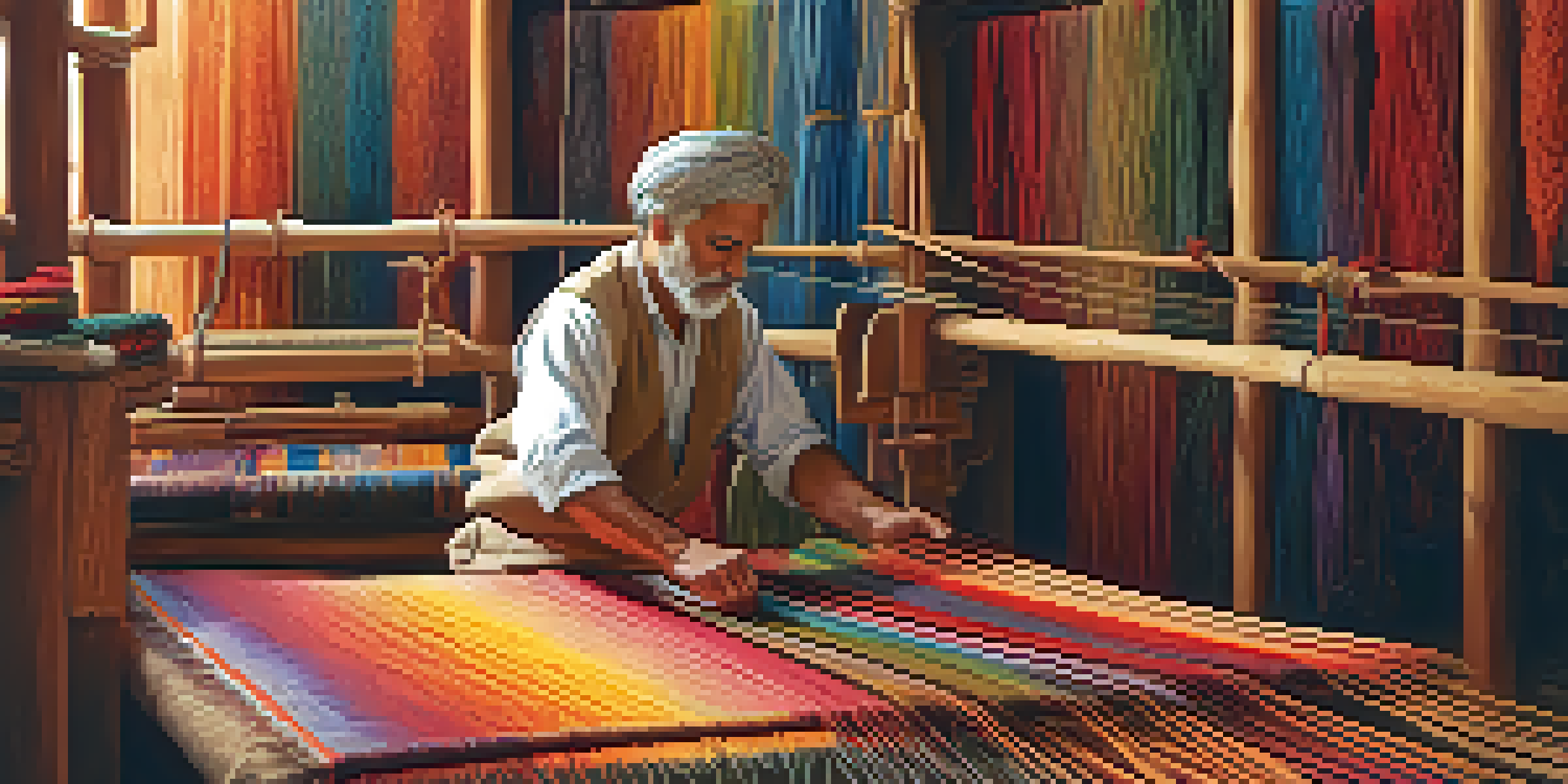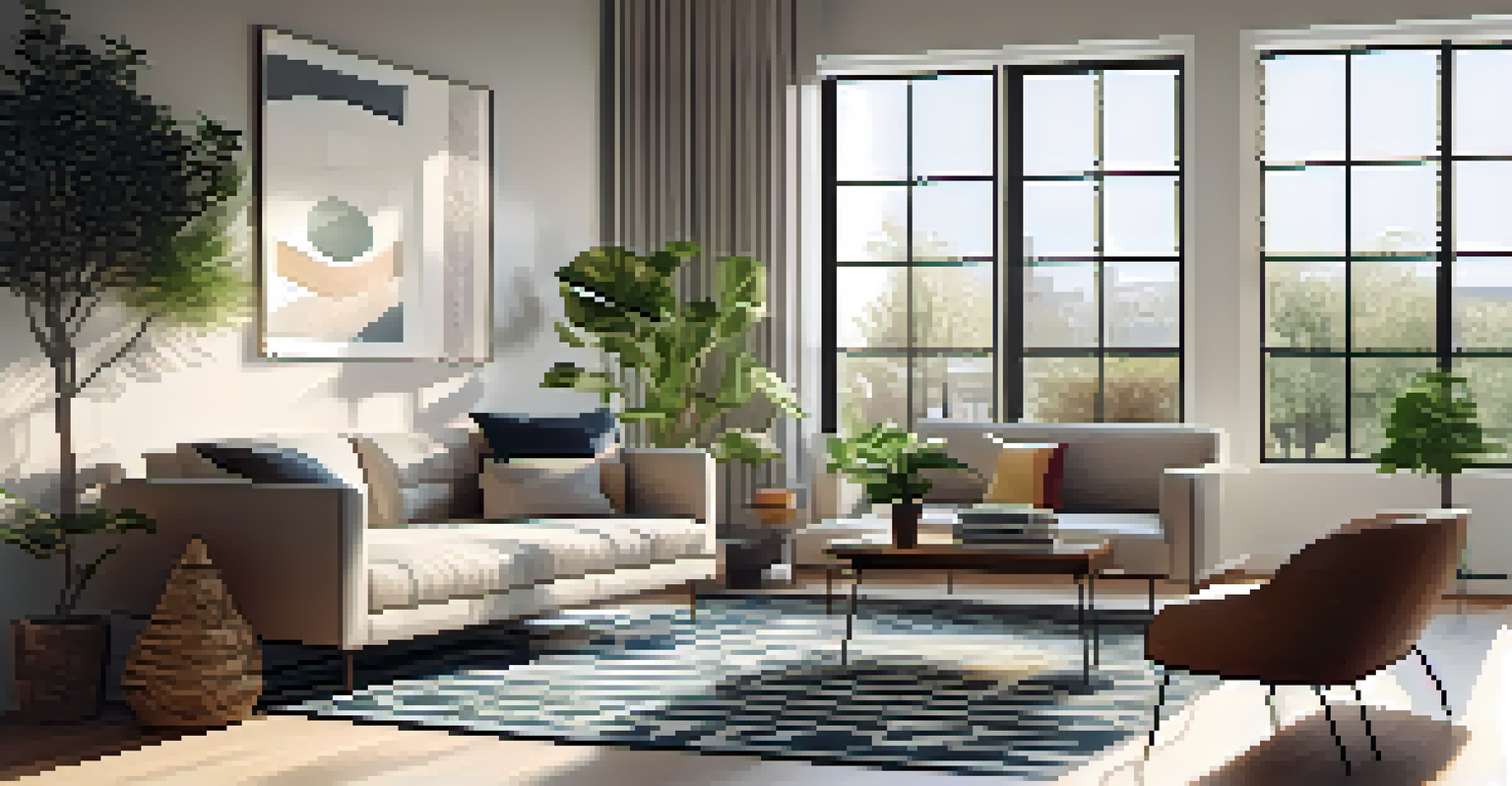Traditional vs. Modern Rug Making Techniques Explained

Understanding Traditional Rug Making Techniques
Traditional rug making is an age-old craft that has been passed down through generations. Artisans often employ methods that are deeply rooted in their cultural heritage, using tools and materials that have stood the test of time. For instance, techniques like hand-knotting and flat-weaving are common, relying on the skill and patience of the weaver to create intricate patterns.
Rugs are like the stories of our lives, woven together with memories and artistry.
The materials used in traditional rug making typically include natural fibers such as wool, cotton, and silk. These fibers not only add to the durability of the rugs but also contribute to their unique textures and warmth. Each piece tells a story, often reflecting the traditions and motifs of the weaver’s community, making every rug a work of art.
Moreover, the process itself can be quite labor-intensive, often taking months or even years to complete a single rug. This dedication to craftsmanship results in pieces that are not just functional but also highly valued as decorative art. In a world increasingly dominated by mass production, traditional rug making remains a testament to skill and heritage.
The Evolution of Modern Rug Making Techniques
Modern rug making has embraced technology and innovation, leading to new methods that significantly differ from traditional practices. For example, machine-made rugs can be produced at a fraction of the time, utilizing advanced machinery that replicates intricate designs with precision. This shift has made rugs more accessible and affordable for consumers.

In addition to speed, modern techniques often incorporate synthetic materials alongside traditional fibers. These materials can enhance durability and ease of maintenance, appealing to a contemporary audience that values both aesthetics and practicality. However, this can sometimes lead to a loss of the artisanal quality that traditional rugs possess.
Traditional vs. Modern Techniques
Traditional rug making emphasizes handcrafted artistry using natural fibers, while modern techniques leverage technology and synthetic materials for efficiency and affordability.
Modern designers also experiment with bold colors and abstract patterns, pushing the boundaries of what a rug can be. This creative freedom allows for a diverse range of styles that fit seamlessly into modern interiors, catering to evolving tastes. While traditional techniques celebrate the past, modern methods pave the way for new artistic expressions in the realm of rug design.
Key Differences Between Traditional and Modern Techniques
One of the most significant differences between traditional and modern rug making lies in the craftsmanship involved. Traditional methods emphasize handwork, where each knot or weave is created with meticulous attention. In contrast, modern techniques often rely on machines, which can produce rugs more quickly but may lack the unique touch of handmade artistry.
The beauty of a rug lies not just in its design but in the craftsmanship and culture it represents.
Another distinction is the materials used in production. Traditional rugs are typically crafted from natural fibers, which contribute to their lasting beauty and tactile quality. Conversely, modern rugs frequently utilize synthetic materials, enhancing durability and affordability but sometimes compromising the authenticity and warmth that natural fibers provide.
Lastly, the design philosophy varies greatly between the two. Traditional rugs often reflect cultural heritage and storytelling, while modern rugs focus on contemporary aesthetics and functionality. This divergence showcases how the art of rug making has adapted to meet the needs and preferences of different generations, each with its own unique vision.
Environmental Impact of Rug Making Techniques
The environmental impact of rug making is an important consideration, especially in today's eco-conscious society. Traditional rug making methods generally have a smaller carbon footprint, as they often utilize natural materials and are crafted by hand. This sustainable approach not only preserves traditional crafts but also supports local communities and economies.
In contrast, modern rug production can lead to increased environmental concerns, particularly with the use of synthetic fibers and mass production techniques. These processes can generate waste and often rely on non-renewable resources, raising questions about sustainability. However, some modern manufacturers are beginning to address these issues by exploring eco-friendly materials and practices.
Cultural Significance of Rugs
Traditional rugs reflect the cultural heritage and communal values of their makers, often serving as storytelling artifacts that strengthen community bonds.
Ultimately, consumers are becoming more aware of the environmental implications of their purchases. This shift has encouraged both traditional and modern rug makers to innovate, finding ways to balance artistry with sustainability. As a result, there’s a growing movement towards responsible rug making that honors craftsmanship without compromising the health of our planet.
Cultural Significance of Traditional Rugs
Traditional rugs often carry deep cultural significance, serving as a reflection of the values, beliefs, and stories of the communities that create them. Patterns and colors can symbolize various aspects of life, from nature to spirituality, making each piece a narrative in its own right. For instance, Persian rugs are renowned for their intricate designs that often tell tales of history and heritage.
Furthermore, these rugs are not just decorative items; they often play a role in social and familial gatherings. In many cultures, the act of weaving a rug is a communal effort, bringing people together to share skills, stories, and traditions. This collective experience strengthens bonds and preserves cultural identities across generations.
As the world becomes more interconnected, the appreciation for these traditional crafts continues to grow. Consumers are increasingly drawn to the stories behind the rugs, opting for pieces that resonate with their values and aesthetics. This trend highlights the enduring relevance of traditional rug making in a rapidly changing world.
Contemporary Trends in Rug Design
Contemporary rug design has seen a significant shift towards minimalism and functionality, reflecting broader design trends in home decor. Clean lines, geometric patterns, and muted color palettes dominate modern collections, appealing to those who favor a more streamlined aesthetic. This move towards simplicity allows rugs to serve as versatile pieces that complement various interior styles.
Moreover, there is a growing fascination with mixed materials in modern rug design. Designers are experimenting with incorporating textiles like jute, leather, and even recycled materials into their creations. This not only adds texture but also promotes sustainability, appealing to environmentally conscious consumers looking for unique and eco-friendly options.
Choosing the Right Rug
Selecting a rug involves considering its purpose, design compatibility, and budget, ensuring it enhances both the aesthetic and functionality of your space.
The rise of custom and bespoke rugs has also become a popular trend, allowing consumers to express their individuality. By collaborating with designers, homeowners can create pieces that reflect their personal style and fit seamlessly into their space. This emphasis on personalization underscores the evolving nature of rug design, merging traditional craftsmanship with modern sensibilities.
Choosing the Right Rug for Your Space
When it comes to choosing a rug, understanding the different techniques and styles available can be immensely helpful. Consider the function of the space where the rug will be placed—high-traffic areas may benefit from more durable, modern options, while a cozy living room might call for the warmth of a traditional handmade piece. By aligning the choice of rug with the room’s purpose, you can enhance both aesthetics and practicality.
It’s also essential to think about the design and color scheme of your home. Traditional rugs often feature rich colors and intricate patterns, making them statement pieces that can anchor a room. On the other hand, modern rugs with minimalist designs can add a touch of sophistication without overwhelming the space. Choose a rug that complements your existing decor while also reflecting your personal style.

Lastly, consider your budget and the investment you’re willing to make. While traditional rugs may come with a higher price tag due to their craftsmanship, they often appreciate in value over time. Modern rugs, while generally more affordable, can also provide excellent value depending on the materials used. By weighing these factors, you can confidently select a rug that not only beautifies your space but also aligns with your lifestyle and values.